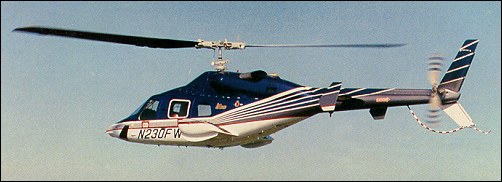
| Bell Model 230 1976 |  |
 |

| Bell Model 230 1976 |  |
 |
|
During the autumn of 1989, Bell announced its intention to develop an improved variant of its Bell 222. Powered by two 700shp Allison 250-C30-G2 turbines driving an advanced design two-blade rotor, the Model 230 could carry up to ten people in a 3.8m3 passenger compartment. Internal fuel capacity had been increased to 930 litres with a maximum of 1359 litres with optional fuel tanks. A fixed skid undercarriage is also available and, from the 51st production aircraft, Bell will offer a variant powered by Lycoming LTS101-750 turbo-shafts. This helicopter is to be built at the company's facility in Canada. Two prototypes have been built at the Mirabel factory near Montreal and the first of these (registered C-GEXP) accomplished its maiden flight on 12 August, 1991 with certification expected during the first quarter of 1992. An initial order for twenty has been placed by Bell's Japanese representative Mitsui & Co, in Tokyo, with first deliveries due in August 1992. A.J.Pelletier "Bell Aircraft since 1935", 1992
Announced at 1989 NBAA Convention; two Bell 222s converted at Mirabel, Canada 1990-91; first flights 12 August (C-GEXP) and 3 October (C-GBLL) 1991; Transport Canada type approval 12 March 1992; production aircraft first flight (C-GAHJ) 23 May 1992; deliveries began 16 November 1992. Total 37 delivered by January 1998; low-rate production continuing. CURRENT VERSIONS: Utility and Executive models, similar to corresponding versions of Bell 222. EMS (Emergency Medical Service): versions also available. Military: Variable configurations. Demonstrator (N230CN) leased for six months by Chilean Navy 1993-94, equipped for shipboard evaluation with Indal ASIST deck recovery system, auxiliary fuel tanks, Breeze Eastern BL 1600 rescue hoist, AlliedSignal RDR 1500B radar, Teledyne AN/APX-101 transponder, AlliedSignal KHF-950 SSB transceiver, Magnavox AN/ARC-164 UHF, Rockwell AN/ARC-186 VHF, Spectrolab SX-5 Starburst searchlight, Agema thermal imager in Heli-Dyne turret, Honeywell EDZ-705 EFIS with SPZ-7000 AFCS, Trimble TNL 7880 GPS/Omega and Flight Visions FV2000 HUD. Following description refers to initial production aircraft with Allison engines: DESIGN FEATURES: Replaced Bell 222; AlliedSignal LTS 101 turboshafts of Bell 222 replaced by Allison 250-C30G2s in first 50 aircraft; main and tail rotors substantially same as Bell 222, former having Wortmann 090 blade section with 8 per cent thickness/chord ratio and swept tips. Independent (hydraulic) rotor brake. Short span sponson each side of fuselage houses mainwheel units and fuel tanks, and serves as work platform. FLYING CONTROLS: Fully powered hydraulic, with elastomeric pitch change and flapping bearings; fixed tailplane with leading-edge slats and endplate fins; strakes under sponsons; single-pilot IFR system without autostabilisation. STRUCTURE: Substantially as Bell 222. Two-blade main rotor with stainless steel spars and leading-edges, Nomex honeycomb trailing-edge with glass fibre skin, and glass fibre safety straps; tail rotor blades stainless steel. Aluminium alloy fuselage with integral tailboom and some honeycomb panels. LANDING GEAR: Tubular skid type on Utility version. Executive version to have hydraulically retractable tricycle gear, single mainwheels retracting forward into sponsons; forward-retracting nosewheel fully castoring and self-centring; hydraulic disc brakes on main units. POWER PLANT: First 50 aircraft to be powered by two Allison 250-C30G2 turboshafts, each rated at 522kW for 5 minutes for T-O, 464kW maximum continuous, 581kW OEI for 2.5 minutes and 553kW OEI for 30 minutes. Main transmission rated at 690kW for T-O, 652.5kW maximum continuous and 548kW for single-engined operation. Usable fuel capacity 935 litres in skid gear version, 710 litres in wheeled version. Optional 182 litres of auxiliary fuel for both versions. ACCOMMODATION: Standard layout has forward-facing seats for nine persons (2-2-2-3) including pilot(s). Options include eight-seat executive (rear six in club layout), six-seat executive (rear four in club layout with console between each pair), or 10-seat utility (2-2-3-3, all forward-facing). Customised Emergency Medical Service (EMS) versions also available, configured for pilot-only operation plus one or two pivotable stretchers and four or three medical attendants/sitting casualties respectively. Two forward-opening doors each side. Entire interior ram air ventilated and soundproofed. Dual controls optional. SYSTEMS: Dual hydraulic system (dual for main rotor collective and cyclic, single for tail rotor). Dual 28V DC electrical system, powered by two 30V 200A engine-mounted starter/generators (derated to 180A) and a 24V 28Ah Ni/Cd battery. ECS optional. AVIONICS: Comms: AlliedSignal Gold Crown III KTR 908 VHF com radio and KMA 24H-71 ICS standard. EQUIPMENT: Standard equipment includes rotor and cargo tiedowns, ground handling wheels for skid version, retractable 450W search/landing light. Options include dual controls, auxiliary fuel tankage, force/feel trim system, more comprehensive nav/com avionics, 136kg capacity rescue hoist, 1,270kg capacity cargo hook, emergency flotation gear, heated windscreen, particle separator and snow baffles. Jane's Helicopter Markets and Systems
- The 430, a stretched version of the 230 with a four-bladed rotor, flew in 1994.
|